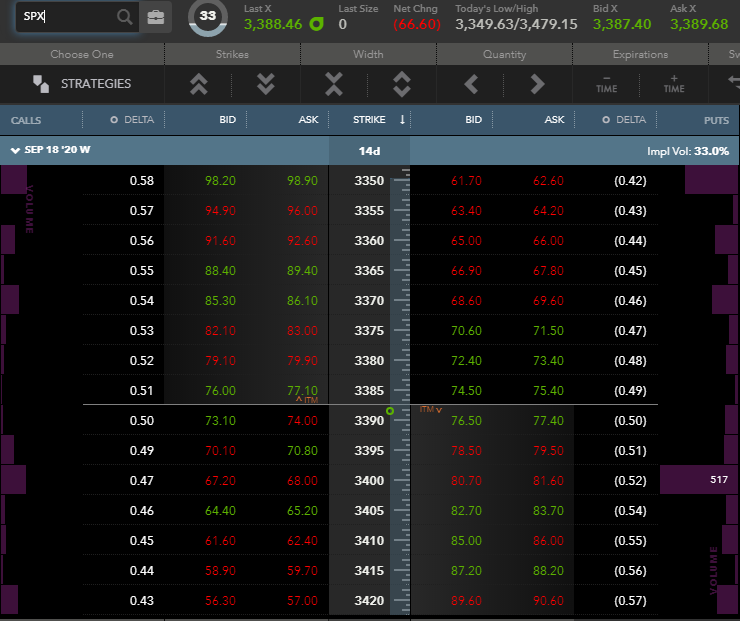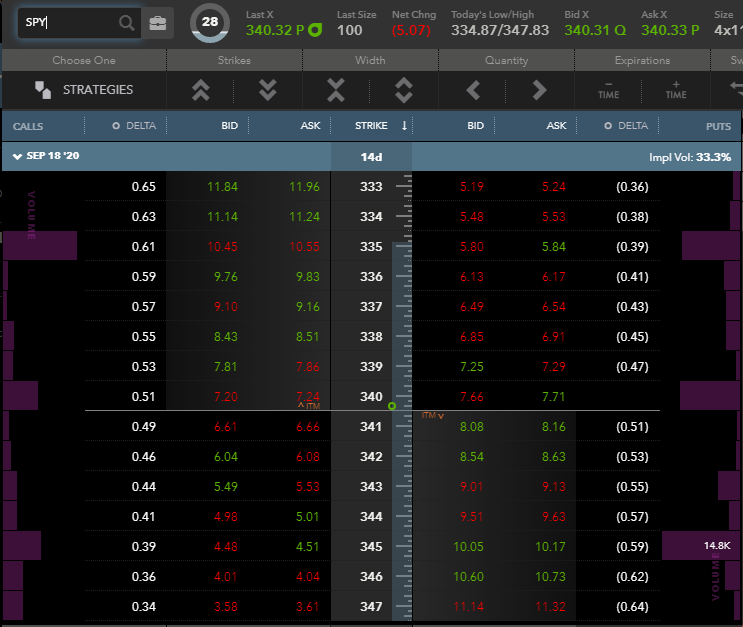Many novice options traders are initially confused by the difference between the options on cash indices like SPX and the options traded on stocks and ETFs like AAPL or SPY.
After all, you can’t trade indices like SPX on the stock market. It’s just an index!
So let’s settle a few differences. Firstly, why are there even options on a cash index like SPX when you can simply trade options on the S&P 500 ETF, SPY?
An index like SPX or NDX are simply math calculations. They take each component’s weightings in the index and automatically calculate the index price based on the price changes in the underlying components.
You can’t trade shares of these, but you can trade options on them. And the way the options trade is slightly different from the traditional stock options you’re probably used to.
On the other hand, an ETF like SPY is an actual company which holds shares that reflect index components in a trust. So when you trade SPY, you’re trading a portion of the actual trust.
Trading shares or options on SPY are structurally no different than trading shares or options of AAPL or IBM.
Before we get into the individual differences between index and stock options, let’s first settle on what an option actually is.
What is an Option?
An option is a contract between a buyer and a seller of an asset. Options contracts could be created for just about anything. They’re popular in the real estate market, for example.
An option contract grants the contract buyer the right, but not the obligation, to purchase an asset at a specified price, and on or before a specified date.
For example, you and I might agree to an option contract on your house. I pay you $1,000 for the right to buy your house at the current market price of $200,000 for the next six months.
You get to keep the $1,000 (known as the “premium” in the options market), no matter what happens, but you can’t sell the house to anyone else until our agreement expires.
Options are pretty much that simple. Perhaps I don’t have the money to buy your house today, but I want to lock in today’s price, so I’d pay you an option premium to have the right to buy it for the next six months.
In the stock market, you can buy or sell (‘write’) options on any stock/ETF/future, regardless of whether you own it.
Now let’s move onto the differences between index and stock options.
List of Index Options
Here’s a list of the most popular index options available on US exchanges:
- $NDX – NASDAQ 100 Index
- $SPX – S&P 500 Index
- $RUT – Russell 2000 Index
- $DJX – Dow Jones Industrial Average 1/100 Index
- $OEX – S&P 100 index
- $VIX – S&P 500 Volatility Index
- $XEO – S&P 100 (European) Index
Keep in mind that many brokers and charting platforms require you to prefix the ticker with the dollar sign ($), because these are ‘cash’ indices, while others just require the ticker.
Other cash-settled index options trade on US exchanges, but most of the others are thinly traded. The CBOE has a list of other index options they offer here.
Index Options Require More Capital
An index option like the SPX requires much more capital per contract than it’s ETF counterpart, SPY, because of SPX’s higher price, which is approximately ten times higher than the SPY.
For example, today’s SPY price is around $347, while today’s SPX price is around $3471.
Contracts for both tickers are denominated for 100-share lots, so you can expect SPX options to cost roughly ten times that of an equivalent SPY option.
Here’s an example of an SPX option chain:
And here’s an example of a SPY option chain:
As you can see, for each equivalent strike, SPX options cost roughly 10x more than SPY options.
Index Options Are Cash Settled
Index options are European-style options, which are mostly the same as the standard American-style options we’re used to trading on individual stocks like Apple or Amazon.
Still, they do have a few key differences. One of those is the settlement.
If I were to buy one call option on an individual stock like Apple and it expired in-the-money, the option would settle in shares. So at the close of expiration Friday, 100 shares of Apple would be credited to my account at my strike price.
Index options, on the other hand, are cash-settled. This means that instead of crediting shares to your account at settlement, your account would simply be credit for the option’s intrinsic value.
Suppose we bought a $330 SPY call option for $3.00, and the price of SPY was $340 at option expiration.
At settlement, our broker would automatically purchase 100 shares of SPY at $330, leaving us a profit of $10 per share. Our net profit after factoring in the cost of the option would be $7.00.
If we bought the equivalent SPX call option, at $3300.00, paid $30.00, and the price of SPX was $3400.00 at expiration. At settlement, our broker would credit us the intrinsic value of the option in cash.
Index Options Are Taxed Like Futures
The main reason that index options typically receive more volume than their ETF counterparts is due to their tax treatments. Under the IRS code, index options are designated as “1256 contracts,” which get special tax treatment. These unique tax treatments are as follows:
- 60/40 Tax Treatment
- 60% of your P&L is treated as long-term capital gains
- 40% of your P&L is treated as short-term capital gains
- This treatment applies regardless of holding period, making futures and index options more tax-advantageous than their ETF counterparts.
- Not subject to wash-sales (a big deal for day traders)
- Your P&L is marked to market at the end of the year, regardless of whether you closed your position.
Let’s create an example to illustrate the benefit of the 60/40 rule for index options. You trade an Apple option and make $100 in gross profits with a one week holding period.
Then you trade an index option and make $100 in gross profits with a one week holding period.
For the stock option, the entire $100 is subject to the short-term capital gains tax. Of course, these tax rates vary dramatically based on your annual income. Let’s assume you’re in the top tax bracket and subject to the highest taxes to keep things simple.
Stock Option:
- $100 profit
- Subject to highest short-term capital gains tax: 37%
- Total taxes owed: $37
Index Option:
- $100 profit
- Subject to highest long-term capital gains tax for 60% of profits: 20%
- Long-term taxes owed: (100 * .6) * .2 = $12
- Subject to highest short-term capital gains tax for 40% of profits: 37%
- Short-term taxes owed: (100 * .4) * .37 = 14.80
- Total taxes owed: $12.00 + $14.80 = $26.80
Add some zeroes to the end of those numbers and see how significant the savings are at scale.
Index Options Have Different Settlement Rules
Index options and stock options have significantly different settlement rules. Not knowing these differences can land you in a world of trouble.
Talking about the nuances of settlement is boring, but these are the types of things that you really only need to learn once and can potentially save you from a big headache if you’re an active options trader.
Index options settle differently from product to product and based on whether they’re regular or weekly options. Weekly index options can settle similarly to a normal stock, while regular index options have some differences.
The first difference is the day of expiration. If you’re used to trading stock options, Friday is typically expiration day, but index options typically settle on Thursday’s close.
The time of expiration is also different. Index options settle based on the first trade made on Friday morning.
So they technically settle on Friday morning, but for all practical purposes, they settle on Thursday, because you would never be able to trade them on Friday morning.
Stock options, on the other hand, expire on Fridays.
So, as a general rule: index options expire on Thursday’s close, stock options expire on Friday’s close.
Pros and Cons of Index Options
Pros:
- Preferable tax treatment
- More liquid markets
- The small number of indices may be a benefit in that you have fewer things to focus on. The thousands of choices in the stock market can be intimidating and distracting.
- Cash settlement makes things more simple.
Cons:
- Fewer choices; there are thousands of optionable stocks, compared to a handful of optionable indices.
- Generally require more capital to trade.
- Less potential to find inefficiently priced options
Final Thoughts
Index options offer traders and investors the opportunity to easily speculate or hedge their positions in a liquid market with preferential tax treatment.
They’re not for everyone, however, as their vast buying power requirements lockout smaller traders.
To summarize:
- Index options have different expiration dates.
- Index options are cash-settled, rather than physically settled.
- Index options are generally more liquid.
- Index options receive preferential tax treatment.
- V]https://www.warriortrading.com/index-options-vs-stock-options/


No comments:
Post a Comment